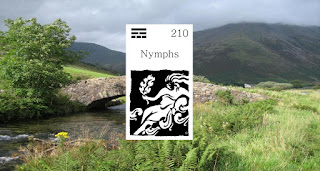Salmon (Knowledge)
As a magical creature of the waters that is close to powers of the Otherworld, the salmon brings knowledge and wisdom, expressing them through the creative arts, especially poetry, prose, and singing. Ancient bards were inspired by tasting the salmon of knowledge.
Invoking Spontaneity and Artistry.
IF YOU ARE DRAWN TO THIS ORACLE, the unspoiled wisdom within your nature seek expression in the creative arts, especially poetry, prose, drama, and singing. Even without special training or talent, creative pursuits seem satisfying and want to be spontaneously expressed. Routine activities may suddenly seem revitalized with insight. Creative and ingenious people attract you. The grandeur of nature is a great source of joy and inspiration.The magical salmon brings supernatural knowledge and wisdom. Taliesin, the ancient bard of Wales, was retrieved from a salmon weir in the River Convey. In the Finn Cycle of Ireland, the red-speckled salmon living in a pool on the River Boyne acquires great knowledge by eating the berries of the rowan tree overhanging the pool. When Finn tastes one of the salmon, he acquires knowledge of everything in the world, past, present, and future, and becomes as great a poet as he is a warrior and hunter.
In Irish and Welsh legends, the salmon captures the wonders of otherworldly wisdom. Swimming in pools close to sacred springs and feeding on rowan berries, salmon acquire knowledge of all there is to know.
The Finn Cycle of Ireland chronicles the story of a magic salmon and the giving of the knowledge of all things to Finn. To acquire greater wisdom, Finn goes to learn poetry from Finneces, who lives on the shores of the magical River Boyne (Bóinn), encamped there for seven years attempting to catch one of the red-speckled salmon that live in a pool by the river. The salmon eat the berries that fall from a rowan tree overhanging the pool and acquire the knowledge of all there ever was to know. Whoever eats one of the salmon will enjoy the wisdom of the world. When Finn comes to Finneces's camp, the poet has just caught a beautiful salmon. Finneces gives the fish to Finn and instructs him to cook it, but not to eat even the smallest piece. While lifting the salmon off the spit, the skin of fish sears Finn's thumb. Thrusting his thumb into his mouth to ease the pain, the knowledge intended for Finneces goes to Finn. As prophesied, the wisdom of the salmon goes to a fair-haired man named Finn who becomes as great "a poet as he was a warrior and hunter."
In the Celtic world, the bards could both bless and curse with the eloquence of their words. In our time, words can promote good and evil and, therefore, rightful expression requires clarity of mind and heart. Take time to choose your words and expressions carefully.
Like the magical salmon feeding on the rowan berries at the bottom of the pool, wisdom may seem to come from a deep well within you. Fresh insights may nourish many aspects of your life, personally and professionally. New ideas will beg expression in words. If you respect the rights of others, this new (or renewed) artistry in ideas and words will develop and increase.


















